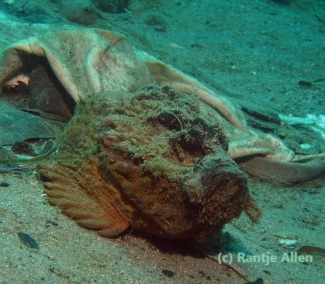Loading content - please wait...
Estuarine stonefish horrify divers
Estuarine stonefish look like ugly stones on the ocean floor. Moreover, they are buried in sand. Divers often pass this deadly fish without noticing.
Lurking Danger
Synanceia horrida is scientific name for the Estuarine stonefish. Famous naturalist Carl Linnaeus found it in Ambon, Indonesia in 1766 and gave the fish its “horrifying” name.
Most often, the Estuarine stonefish will hide under sand or rubble on the substrate. It uses its large pectoral fins to dig down. Then, it will wiggle its body, covering itself with sand. Typically, only its eyes and mouth emerge. Its mouth is always positioned like an unhappy up-side-down smile. Other times, it sits on the substrate looking like an uninteresting rock .
This grumpy looking fish is merely waiting for the right moment. As a night time hunter, the Estuarine stonefish waits for a fish, shrimp, or crustacean to pass by. With sudden inhalation, the fish will suck its prey into the mouth.
Venomous not Poisonous
Like other stonefishes, the Estuarine stonefish has a series of spines. These are usually lying flat onto its back. If the fish it started or feels threatened, it will erect its spines. If someone steps on it or grabs its, the spines will inject venom. This venom quickly and adversely affects the heart and muscles. The pain is extreme and deaths have occurred.
The best emergency treatment is submerging the wound in very hot water. Heat is a general tool for all marine venom and stings. It breaks down the neurotoxins, eventually rendering them neutral. Naturally, any victim should be taken to a medical facility.
Estuarine stonefish and its Lookalikes
Many of the bottom dwelling stonefishes look similar. However, only the Estuarine stonefish has the boney ridge between its eyes. Its eyes point upwards for sunken depression on the fish’s face. The fish’s color is dark and mottled. Oftentimes, filamentous algae will be growing on its body. All this is to disguise the fish’s presence. In Gorontalo, we find this species in muck diving areas.
Similar is the Reef stonefish (Synanceia verrucosa), which is typically found near reefs. It lacks the boney eye ridge and often is more colorful. On our Honeycomb dive site, we find Flasher scorpionfish (Scorpaenopsis macrochir)
, which is much smaller than Estuarine stonefish. Its body is smoother and usually lies flat with its tail stretched straight back among rubble. Lying in plain sight, it is still most difficult to detect. Another similar venomous bottom dweller is the Devil scorpionfish (Scorpaenopsis diabolus). We sometimes find this fish in muck diving sites. Its skin is almost smooth looking. When disturbed, it stretches out its yellow and red banded dorsal fins, as it glides to another place.Advice for Viewing
When divers are enjoying muck diving, they should always avoid laying on the substrate. Many creatures live just under the surface. When threatened, they sting in self-defense. Using a dive stick for positioning is a helpful and safe way to observe marine life without making contact with the ocean bottom, something that can be potentially harmful.
Sometimes, the Estuarine stonefish will be sitting in the open, above the sand. Even so, divers will probably swim right past it since it looks like an ugly stone. Careful inspection will reveal the grumpy curve of its mouth, its wide pectoral fins touching the sand, and its tail curled around its body. Hard to spot are its eyes, which are staring at you.
For your chance to see this stonefish in Gorontalo, please make your dive reservations directly with Miguel’s Diving.







